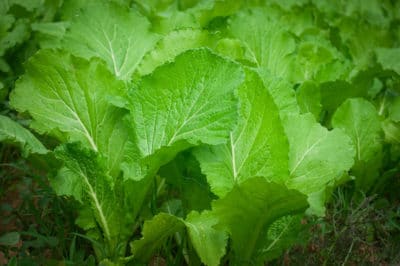Planting Mustard
This is a cool-season vegetable that prefers temperatures below 80°F (26.6°C). Any heat spikes above that and this plant could show signs of stress or bolt. For this reason, the best time to plant mustard is in the cool early spring or the fall. Seeds can go directly into the ground about 3 weeks before the last frost in your region.
Often farmers in milder climates will plant mustard successionally throughout the year. That means sowing seed every three weeks from spring through the fall and even into the winter in some regions. By doing this you ensure that there is always a supply of fresh mustard greens, flower, or seeds.
Popular mustard varieties include:
- Giant Red: Heirloom, Red Leaves, 50 Days
- Greenwave: Heirloom, Lime Green Ruffled Leaves, 55 days
- Tatsoi: Dark Green, Smooth Leaves, 55 Days
Mustard Seed
If growing mustard for its seed, it’s important to know that this plant is a biennial. That means that its lifecycle lasts for two years. The first year it will grow a leaf rosette but show no signs of flowering unless under stress.
The plant will flower and seed early in its second year. You can harvest greens during the first year of a mustard plant and it will still produce healthy seeds the following year.
It may be tempting to allow the plant to bolt and produce seed in its first year, the seeds produced will be small and low quality. It is far better for the quality of your harvest to allow the plants their natural lifecycle.
Harvesting Mustard
Mustard can be harvested at any stage. It is even a popular microgreen plant, which is harvested as soon as the first true leaves appear or shortly after. Harvest it when leaves are 3 inches tall for a baby green, or wait until they are thick and mature to harvest great cooking green.
Flowers are also edible, they carry the same spicy kick that the leaves and seeds have. Many gardeners harvest mustard flowers and use them fresh to beautify dishes or add them to spirits and cooking oils for flavor infusion. Infusing wines and oils with mustard flowers is a technique dating back to ancient Rome.
After the plant flowers, it will produce seed pods. The pods will eventually turn brown and crisp and this is when you should harvest them. A few plants will provide enough seed to keep you in all the fancy mustard making recipes you can find.
